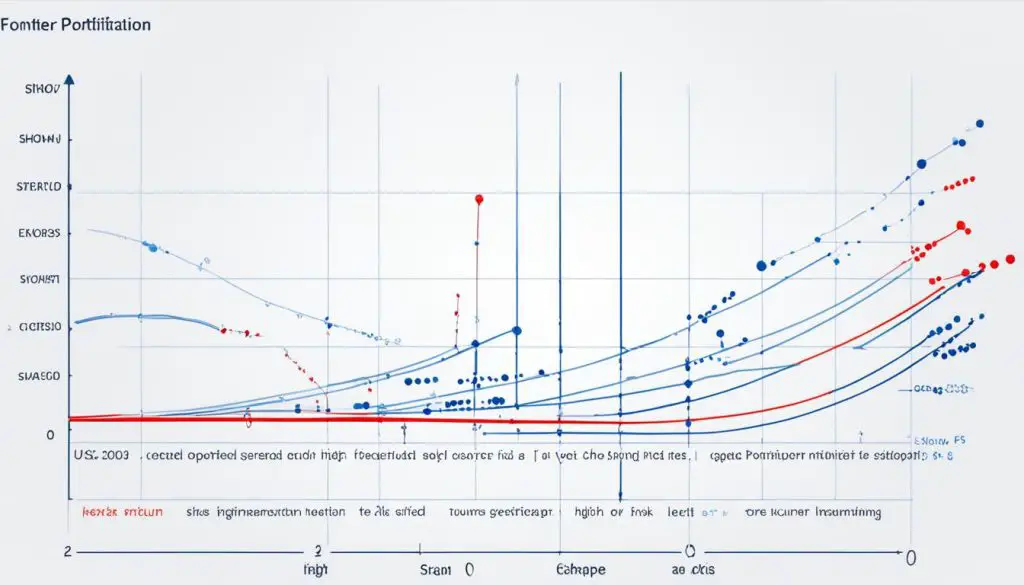The max Sharpe ratio portfolio optimization is a smart method for getting the most out of your investments. It focuses on picking assets that bring high returns while keeping risks in check. This approach is all about balancing risk and reward wisely.
By following this technique, investors can choose their assets carefully. They aim for the best mix that promises good returns with little risk. Sound strange? Read on to learn more about how to manage your portfolio for the highest gains.
Key Takeaways
- Max Sharpe ratio portfolio optimization focuses on risk-adjusted returns.
- The technique helps in achieving an optimal asset allocation.
- It enhances the potential for investment growth.
- The methodology is rooted in solid mathematical principles.
- Practical applications make this approach valuable for various investment scenarios.
Introduction to Portfolio Optimization
Portfolio optimization is key to a strong investment plan. It combines math accuracy with smart strategies to get the most returns with a set risk level. It’s a key part of keeping an investment healthy and making investors feel secure.
What is Portfolio Optimization?
It means making an investment mix to get the best return for a certain risk level. This is a big part of managing risk, making sure your investments work well together.
It uses many methods, like diversification and choosing different types of assets. These methods are picked based on how much risk an investor is willing to take and what they want to earn. This helps make a strong and varied investment plan.
The Importance of Portfolio Optimization
Portfolio optimization isn’t just theory; it has real effects. It helps investors handle market changes and grow their money in a stable way. It also stops one type of investment from affecting the whole plan too much.
To lower risk, diversification is crucial. It lessens losses from single investments. With this, investors can lay a solid groundwork for their financial future. This builds confidence and ensures their money stays safe.
Understanding Max Sharpe Ratio Portfolio Optimization
The max Sharpe ratio is a key measure for finding the best risk-adjusted returns in a portfolio. It helps choose the best mix of assets. This ensures investors see the most growth for their risk level.
Definition and Purpose
The max Sharpe ratio aims to find the best asset mix. It looks for the mix where return over the risk-free rate is high compared to volatility. This helps investors see which asset mix is the most efficient for its level of risk.
Calculating the Sharpe Ratio
The Sharpe Ratio is key to measuring risk-adjusted returns. It’s calculated by:
Sharpe Ratio = (Rp – Rf) / σp, with:
- Rp as the portfolio return
- Rf is the risk-free rate
- σp is the portfolio’s excess return standard deviation
This formula shows how good a portfolio is at managing risk for its return. It helps investors find out the best mix of assets.
The table gives a look at how the Sharpe Ratio helps compare different portfolios. It shows their risk-adjusted returns based on assets.
| Portfolio | Portfolio Return (Rp) | Risk-Free Rate (Rf) | Standard Deviation (σp) | Sharpe Ratio |
|---|---|---|---|---|
| Equities-Dominated | 10% | 2% | 15% | 0.53 |
| Balanced Mix | 8% | 2% | 10% | 0.60 |
| Bonds-Focused | 5% | 2% | 5% | 0.60 |
Efficient Frontier and Modern Portfolio Theory
The efficient frontier and modern portfolio theory are key to making the most of your portfolio. They help investors build portfolios that balance risk and reward well.
The Concept of Efficient Frontier
The efficient frontier is the group of portfolios with the best chance for high returns at a particular risk level. When these portfolios are graphed, investors see how risk affects potential rewards. The optimized portfolios fall along a curve, which is the efficient frontier.
Applying Modern Portfolio Theory
Harry Markowitz introduced modern portfolio theory (MPT). It says an investment’s risk and return shouldn’t be looked at alone but as part of the portfolio’s overall status. MPT helps investors create diversified portfolios that match both their risk comfort and return goals.
| Concept | Description |
|---|---|
| Efficient Frontier | A graph representing optimal portfolios that offer the highest return for a defined level of risk. |
| Modern Portfolio Theory | A framework that helps in constructing diversified portfolios to optimize risk and return. |
| Risk-Return Tradeoff | The balance between the potential risk and expected return in portfolio management. |
| Portfolio Diversification | Investing in various assets to reduce overall risk. |
Steps to Maximize Portfolio Diversification
Optimizing your portfolio diversification is key to reducing risks and improving returns. This guide shows steps for investors to boost their portfolios. It includes tips for using a mix of assets wisely.
Asset Allocation Strategies
Good asset allocation spreads your money across different types of investments. This can be stocks, bonds, or real estate. The goal is to do this in a way that matches how much risk you’re okay with and meets your financial aims. A smart mix usually has:
- Figuring out the right blend of asset classes based on how long you plan to invest and how much risk you can take.
- Regularly checking and adjusting your investments to keep the right mix.
- Adding types of investments that aren’t traditional to make your portfolio more varied.
Balancing Risk and Return
It’s crucial for investors to find the sweet spot between risk and return. This involves making your portfolio safer while aiming for good performance. Here’s how to do it:
- Look at how individual investments have done in the past and how risky they are.
- Use tools like the Sharpe Ratio to see if your portfolio’s set up for strong results.
- Making sure your investments within an asset class vary enough to lower specific risks.
The perfect mix of asset classes in a portfolio looks like this:
| Asset Class | Allocation Percentage |
|---|---|
| Stocks | 50% |
| Bonds | 30% |
| Real Estate | 10% |
| Alternative Investments | 10% |
Using these strategies helps investors balance the risks and rewards in their portfolios well.
Implementing Max Sharpe Ratio Portfolio Optimization
Using the max Sharpe ratio optimization means improving how your investments perform. You have to follow key steps to make your investment portfolio work better. These steps include:
- Assessment: First, look closely at what you have in your portfolio. Know the risks, what you could get back, and where your assets are.
- Strategy Design: After looking at your current situation, develop a plan that fits your goals. Make sure your plan follows the max Sharpe ratio principles.
- Performance Review: Keep checking how well your investments are doing. This means seeing if you’re still on track or need to change because of market moves or new goals.
Working with the max Sharpe ratio means always watching and changing your plans. A balanced portfolio manages risks and rewards well to get the best returns. Following these steps gives you a strong method for investment portfolio optimization. This helps your investments grow and stay strong over time.
Advanced Risk-Adjusted Return Techniques
Advanced risk-adjusted return techniques improve how investors get the best results. They count lots of risks and complex stats for better returns. These methods include a variety of investments to reach the right risk levels for returns.
Using Statistical Metrics
Using advanced stats helps make risk-adjusted returns better. Metrics like VaR, CVaR, and Omega Ratio show us more about possible losses. They help in choosing the right strategy based on how much risk you’re okay with and your goals. With these tools, smarter choices are made and risks are managed well.
Incorporating Alternative Investments
Adding alternative investments diversifies and lowers risks in portfolios. Hedge funds, private equity, and real estate can act differently from stocks and bonds. This difference can protect against ups and downs in the market. So, using these investments can improve returns without breaking the risk rules.
Overall, using advanced techniques and diversifying through alternative investments can boost a portfolio’s success. With detailed stats and a mix of investments, investors can handle today’s financial markets better. They aim for better returns over time, wisely.
Conclusion
Max Sharpe ratio portfolio optimization is a key strategy to boost investment portfolios. This guide explored the strategy’s basics, its application, and advanced methods. It focuses on balancing risk and reward. This ensures your portfolio can grow while staying strong.
This strategy is about finding the perfect mix of risk and return. By using Modern Portfolio Theory (MPT), it becomes even stronger. MPT helps us make smarter choices about where we put our money.
The future of managing portfolios will keep getting smarter. Adding max Sharpe ratio portfolio optimization to your strategy helps. It means better performance and understanding today’s financial world. Take on this advanced method for lasting success and smart investing.
FAQ
What is Portfolio Optimization?
Portfolio optimization is a way to build an investment mix. It looks to earn the most return for a set risk. This approach helps balance diversification strategies in investing.
Why is Portfolio Optimization Important?
It’s key for long-term investment success and confidence. By optimizing, you aim to get the most returns with controlled risks. This ensures your portfolio is well-rounded.
What is the Max Sharpe Ratio?
The max Sharpe ratio aims to get the best return considering risk. By doing this, it helps find the best way to divide funds in an investment portfolio.
How is the Sharpe Ratio Calculated?
The Sharpe ratio looks at a portfolio’s return minus the risk-free rate. Then, it’s divided by its standard deviation. This formula tells you about a portfolio’s risk and return.
What is the Efficient Frontier?
The efficient frontier is a range of the best possible portfolios for a risk level. It’s key in helping investors see their options for risk and return trade-offs clearly.
How Does Modern Portfolio Theory Apply to Portfolio Optimization?
Modern Portfolio Theory finds the best mix of assets for highest return and lowest risk. It uses diversification well to guide real-world investing decisions.
What are Asset Allocation Strategies?
Asset allocation is about spreading investments across different types. This includes stocks, bonds, and cash. The aim is to balance risk and returns, following the max Sharpe ratio model.
How Can I Balance Risk and Return in My Portfolio?
To balance risk and return, know your risk comfort, time you plan to invest, and goals. Using specific asset allocation methods and the Sharpe ratio can find this balance.
What Steps Are Involved in Implementing Max Sharpe Ratio Portfolio Optimization?
Start by checking your current investments. Then, craft the best way to allocate assets. Always review and adjust to meet your goals for returns and risk.
What are Advanced Risk-Adjusted Return Techniques?
These strategies use complicated math and might include non-traditional investments. They help to get the most returns by managing risk wisely within the Sharpe ratio guidelines.
How Can I Incorporate Alternative Investments into My Portfolio?
Additions like real estate and private equity can make your investments safer and more profitable. Make sure these fit with the Sharpe ratio strategy for a well-adjusted mix.






